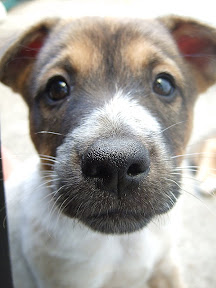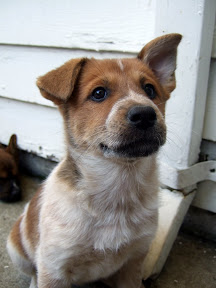To reaffirm how cute these pups are, I took a bunch of new pictures.
 |
| From super-cute |
 |
| From super-cute |
Hazels pups are half McNab and half Australian Cattle Dog mix. The puppies will most likely have strong herding instincts – They will need to be “working” most of the day to be happpy.
I found these articles and thought it would be helpful to understand the needs of the pups:
Is a herding dog right for you and your lifestyle?
Very good question and one that needs serious thought, in all directions - and - all angles. First ask yourself if sharing your life with a canine is something you will devote yourself to - rain, snow or shine, 24 hours, seven days a week whether you are sick, happy or sad, for the next 13 or so, years. Understand that canines require a care taker, handler, trainer and friend - all wrapped up in one body - yours. While we humans enjoy a warm and loving companion the responsibilities go far beyond all of the warm and fuzzy stuff.
All canines require the following:
1. Training
2. Quality food
3. Fresh water
4. Daily grooming - bathe as necessary.
5. Warm shelter and shade in the summer.
6. A safe and securely fenced yard.
7. Vaccinations
8. De-worming
9. Veterinarian exam - yearly.
10. Daily walks and activities.
11. Daily positive ATTENTION
Basic Characteristics of the McNab Shepherd:
Workers:
This breed of canine was bred to work. In the beginning, the McNab Shepherd was bred only to the strongest of the strong, smartest to the smart and bred to the best of the best working McNabs in the state. In the beginning, majority of McNab pups who didn't fit this strict criteria were destroyed. Today, breeders are not as strict however, the breed remains to be true workers with the degree of workability varying. These dogs will never be porch or lap dogs, although they do love a warm lap to climb upon from time to time!
Protection/Devotion:
The McNab is extremely devoted to their human family as well as the property of. Temperaments vary depending on the breeding as temperament IS hereditary. An aggressive, ill tempered female or male WILL past this type of temperament on to their pups. The McNab is not known for ill temperaments. Majority of McNabs are fantastic family dogs. Some do not take kindly to strangers, while others do. Some do not take kindly to outside dogs, while others do. What makes an enormous difference towards what a McNab will accept or not accept is the degree of socialization, beginning as a PUP and continuing on throughout their life. A well socialized McNab who is exposed to a wide variety of activities, situations and everyday life in society will be far more accepting than the McNab who was/is isolated on a farm or ranch.
Question: What type of work does a McNab require to be happy and content?
Answer: Ideally, livestock work (sheep, cattle, fowl, horses and so on). Other type of work which is suitable for the McNab includes agility, fly-ball, tracking, disc, search and rescue, daily jogging partner, for example.
Question: How often does a McNab need to work?
Answer: Daily.
Question: Is the McNab considered a hyperactive breed of dog?
Answer: No. The McNab is not considered hyperactive - however a bored McNab with no work may appear as overly active, as behaviors will arise through such boredom.
Question: What type of behaviors might occur with a bored McNab?
Answer: Excessive barking, digging, chewing, jumping up, chasing cars, cats, birds and other unruly behavior.
Question: What can I do if my McNab begins to behave this way?
Answer: Devote to giving him/her a full time JOB. Educate yourself, train yourself and then share this knowledge with your dog.
Question: Is the McNab good with children?
Answer: Absolutely, as long as the McNab has been exposed to children at a young age. For older McNabs who have never been around children, and/or are poorly socialized, this answer will vary depending greatly on the individual McNab.
Question: How large of a yard is best suitable for a McNab?
Answer: Large yard plus daily work.
Question: Are McNabs Headers or Healers?
Answer: McNabs are natural headers - although some are natural headers AND healers.
Question: What is the McNab's natural style of working?
Answer: Their natural style is to run to the head (get-a head) of the livestock. Gather, bunch, hold and lead. Some will also work the rear (drive).
Question: What is the McNab standard?
Answer: There is not an official standard - however the (classic) McNab has a variety of ear sets, their eyes are almond in shape, their head is sharp. They are more up-right than the classic Border Collie. The McNab's feet are tight - cat like in appearance, however a poorly bred McNab may have flat feet/long toes. Coat colors vary from black with white markings, red with white markings, tan with white markings and tri colored. Coat length also varies from short/tight to medium in length. The classic McNab will never have a long coat, nor will they ever have marbling and/or blue eyes. The appearance of a marbled or blue eye suggests outside blood from either a Border Collie, Aussie or ? The McNab's tail is long and relatively straight with anywhere from a large to a few white hairs located on the tip. Some McNab bloodlines throw a natural bob and even partial tails. This type of tail does not have a white tip (usually). In the early days, McNab tails were not docked. It is preferred by many to keep this tradition going by keeping the tails intact.
 |
| From super-cute |
 |
| From super-cute |
No comments:
Post a Comment